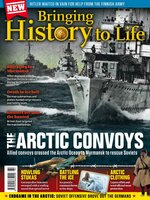In 1933, Adolf Hitler seizes power in Germany, where he has seduced the population with golden promises of a restoration of the Great German Empire. He allies himself with Mussolini's fascist Italy, Stalin's communist Soviet Union and the military dictatorship in Japan, which has the same dreams of grandeur as Germany. In this series, you get a thorough review of World War II - from the birth of fascism through the war's many dramas to the aftermath, where the victors deal with the war's worst criminals.
WELCOME
CONVOYS TO SAVE SOVIET UNION • When the Nazi war machine roared across the borders of the Soviet Union on 22nd June 1941, Britain and the US immediately offered to help the Soviets. The Red Army needed everything – from boots to tanks – so a few months after the invasion, sailors began to ship huge quantities of supplies to the Soviet Union.
BLITZKRIEG IN ARCTIC • Just 100 “ludicrous” kilometres stood between elite German forces and control of Murmansk in the Soviet Union in 1941. Although the distance was short, the war in the Arctic would be brutal. Plagues of mosquitoes and perpetual daylight wore on Nazi morale as Soviet soldiers mounted a desperate defence.
DEATH IN ICE HELL • In 1942, the Nazis felt the impact of the Allies pouring supplies into the Soviet Union. Hitler ordered that the traffic had to be halted immediately, so warships, U-boats and aircraft launched a deadly hunt for the Arctic convoys. Suddenly, the Allied cargo ships were being savagely chased through the icy waters.
“What did I have left after all those years?” • Trygve H Johansen is one of Norway’s most decorated war sailors. He received several medals for his war efforts, including the Soviet Ushakov Medal. The medal is awarded to veterans who sailed with the Arctic convoys and distinguished themselves with acts of bravery in the defence of Russia.
PQ 17 PAID A HEAVY PRICE • In the spring of 1942, the Germans ruthlessly targeted Arctic aid convoys, and PQ 17 would pay the highest price. Fearing the loss of their precious warships, the Allies abandoned 35 cargo ships and left them defenceless in the Barents Sea – with German aircraft and submarines nearby, ready to pounce.
HUNTERS BECAME THE HUNTED • In 1943, the fortunes of war turned. The Allies were no longer the hunted, but the hunters. Not merely content to protect the convoys, the Royal Navy was ready to attack the enemy. The first target was Scharnhorst, Hitler’s last operational battleship. Soon, the giant Tirpitz would also shudder under Allied fire.
ENDGAME IN THE ARCTIC • For three years, the Soviets had held off the German Army at the Litza River in a gruelling stand-off in which the front was literally frozen. But on 7th October 1944, a thunderous storm of fire came from guns, mortars and rocket launchers. The endgame for supremacy in the Arctic was underway.
Why didn’t Hitler take Murmansk? • Hitler believed that having control of the port city of Murmansk was crucial. But even though the Nazi leader knew that convoy after convoy was landing supplies for the beleaguered Soviets, he never ordered a decisive attack on the city. Instead, he relied on Finnish help.
PICTURE INDEX
READING LIST
Bringing History to Life

 The Artic Convoys
The Artic Convoys
 Incredible Weapons
Incredible Weapons
 U-Boat Hunters in the Atlantic
U-Boat Hunters in the Atlantic
 WW2's Darkest Crimes
WW2's Darkest Crimes
 Inside the Third Reich
Inside the Third Reich
 Luftwaffe
Luftwaffe
 The Third Reich - prepared for war
The Third Reich - prepared for war
 Nazi Mysteries
Nazi Mysteries
 Historys Greatest tank Battle
Historys Greatest tank Battle
 Panzer!
Panzer!
 Unsolved Mysteries of WWII
Unsolved Mysteries of WWII
 Fall of Berlin
Fall of Berlin
 Battle of Stalingrad
Battle of Stalingrad
 Special Forces - Equipment! Tactics! Missions!
Special Forces - Equipment! Tactics! Missions!
 The Collapse of Nazi Germany / Western Front
The Collapse of Nazi Germany / Western Front
 Operation Barbarossa
Operation Barbarossa
 Nazi Stormtroopers
Nazi Stormtroopers
 World War II - Key events 1939-1945
World War II - Key events 1939-1945